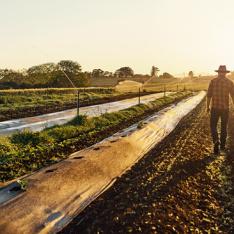Managing risk in broadacre farming
INVESTMENTS in agriculture can be risky. Investments in broadacre farming can be even riskier.

INVESTMENTS in agriculture can be risky. Investments in broadacre farming can be even riskier. So how does an Australian broadacre farmer arrive at an investment decision with clarity of the goal or confidence in the ability to achieve it?
Factors influencing the commercial viability of an agricultural investment constantly vary. Rainfall, yield and prices received vs cost of production always seem to shift from season to season making it tough for a broadacre farmer to arrive at a decision with one hundred percent clarity or confidence they have made the right call.
The investment decision making process for a broadacre farmer is no different from that of the broader financial industry. Investors all around the world look at risk verse reward and forecasting budgets using achievable average numbers.
When an investor looks to invest in a managed financial product they traditionally look at an actively managed fund or an indexed fund. The difference being; an actively managed fund aims to beat the average of an index, for example the largest 100 companies on the ASX over the course of a year. An indexed fund aims to return the average move of the largest 100 companies on the ASX over a year. Proponents of index funds also cite lower costs and lower risk as there is more certainty these funds will return the average.
The question is, despite the actively managed fund aiming to beat the average, will they be able to achieve their goal?
Actively managed funds typically adopt higher risk strategies and charge higher rates for this service. This however, does not guarantee a better financial outcome than an indexed fund which aims to achieve the market average. In fact, there has been numerous occasions where the higher fees charged by the actively managed fund has resulted in a lower net return than indexed funds. Higher risk strategies do not always mean guaranteed returns.
When we use this style of thinking in grain markets it comes down to two simple things; if someone is looking to sell grain are they willing to take on added risk to beat the market average or are they trying to achieve the average of that period?
Utilising this concept of averages when marketing your grain is a smart way to spread your risk. If the market appreciates you will continue to sell as it does so. If the market depreciates you will not sell everything at the lows. The more periods of exposure you choose, the lower the risk. For instance, if you halve your grain and sell it in two equal portions at different times, you will achieve two different prices with one being better than the other. If you split your grain parcel into five portions and sell over five periods you will have five opportunities to sell the highs, only once selling the ‘low’ of that entire period. This will even out your returns. The problem here is, broadacre farmers don’t always have the time to follow the grain markets in detail. Growers spend a significant amount of time growing crops, monitoring rainfall and moisture profiles, working with agronomists, moving livestock and hopefully once in a while going on a holiday. The solution? One option is to use a grain marketing expert to average your returns for you. It further reduces your risk and can increase the overall average in your returns.
This isn’t to say hiring a grain marketer and putting all your eggs in the one indexed sales basket is the right choice for your businesses cashflow needs. However, spreading your grain sales over different marketing programs with different strategies and different fee structures can be the smartest choice to manage your risk, increase your overall average return and help you arrive at an investment decision with clarity of the goal and confidence in the ability to achieve it.
For more information on indexing, call your local Agfarm Account Manager on 1300 243 276 or visit agfarm.com.au/march4


